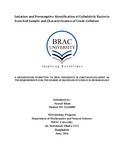| dc.contributor.advisor | Khan, Trosporsha Tasnim | |
| dc.contributor.advisor | Hossain, Dr. M. Mahboob | |
| dc.contributor.author | Khan, Sazzad | |
| dc.date.accessioned | 2017-05-08T04:42:15Z | |
| dc.date.available | 2017-05-08T04:42:15Z | |
| dc.date.copyright | 2016 | |
| dc.date.issued | 2016-06 | |
| dc.identifier.other | ID 12126009 | |
| dc.identifier.uri | http://hdl.handle.net/10361/8100 | |
| dc.description | This Thesis is submitted in partial fulfillment of the requirements for the degree of Bachelor of Science in Biotechnology, 2016. | en_US |
| dc.description | Cataloged from PDF version of thesis report. | |
| dc.description | Includes bibliographical references (page 58- 63). | |
| dc.description.abstract | Microbial cellulases find applications in various industries and constitute a major group of the industrial enzymes. It has attracted attention of many researchers because of its tremendous industrial applications including textile industry, pulp and paper industry, laundry and detergent industry, food and animal feed industry. This study aims to isolate, identify and screen bacteria with high cellulase activity from soil sample. A total of 68 isolates were obtained from soil collected from Bagan Bari Dairy Farm, Keranigonj, Bangladesh. These were screened through clear zone ratio on CMC agar plate with Gram’s Iodine. Of the 68 isolates, 31 isolates gave better zone of hydrolysis and finally two of them (isolate 47 and 66) with maximum clear zone ratios were evaluated by secondary screening for enzyme production. Between these two isolates, isolate 66 was selected as most efficient enzyme producer and its enzyme activity along with specific enzyme activity in the crude sample were found to be 0.165 U/ml and 0.333 U/mg
respectively. The potential isolate 66 was further presumptively identified to be a Bacillus spp. through a series of biochemical tests, colony characteristics and cultural characteristics. It was found to be a gram positive, rod shaped and spore forming bacterium and was facultative anaerobe. The optimum pH and temperature for the activity of crude enzyme was 5 and 65°C respectively .The potential isolate 66 was further checked for filter paper and cotton degradation properties quantitatively. It showed positive result for filter paper degradation and negative result for cotton hydrolysis. | en_US |
| dc.description.statementofresponsibility | Sazzad Khan | |
| dc.format.extent | 85 pages | |
| dc.language.iso | en | en_US |
| dc.publisher | BRAC University | en_US |
| dc.rights | BRAC University thesis are protected by copyright. They may be viewed from this source for any purpose, but reproduction or distribution in any format is prohibited without written permission. | |
| dc.subject | Cellulolytic bacteria | en_US |
| dc.subject | Soil | en_US |
| dc.subject | Crude cellulase | en_US |
| dc.title | Isolation and presumptive identification of cellulolytic bacteria from soil sample and characterization of crude cellulase | en_US |
| dc.type | Thesis | en_US |
| dc.contributor.department | Department of Mathematics and Natural Sciences, BRAC University | |
| dc.description.degree | B. Biotechnology | |

